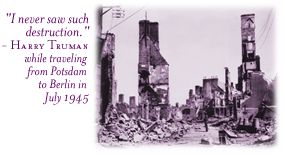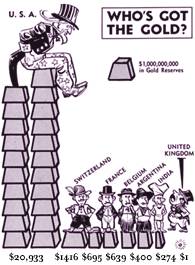Money
Matters: An IMF Exhibit -- The Importance of Global Cooperation
|
Destruction
and Reconstruction (1945-1958)
|
Part
1 of 6
|
|
|
|
| |
The
Post War World
|
| Conflict
and Cooperation |
Next--> |
| |
The
Most Destructive War in History
|
By
the end of World War II, much of Europe and Asia, and parts of Africa,
lay in ruins. Combat and bombing had flattened cities and towns, destroyed
bridges and railroads, and scorched the countryside. The war had also
taken a staggering toll in both military and civilian lives.
Shortages of food, fuel, and all kinds of consumer products persisted
and in many cases worsened after peace was declared. War-ravaged Europe
and Japan could not produce enough goods for their own people, much
less for export.
What was needed to pull Europe and Asia back into the international
economy? The answer was money - but what kind? The currencies
of war-torn countries? Gold? Dollars?
|

credits |
The
Most Expensive War in History
|
In
addition to the toll in human lives and suffering, countries spent
more money on World War II than in all previous wars put together.
By 1945, exhausted countries faced severe economic problems that frustrated
reconstruction efforts:
- Inflation
- Debt
(mostly owed to the United States)
- Trade
deficits
- Balance
of payments deficits
- Depleted
gold and dollar supplies
|
The
Dollar Gap
|
The
devastated countries needed gold or U.S. dollars (the only currency
considered to be "as good as gold") to pay for imports
and make debt payments. However, both dollars and gold were
alarmingly scarce in the war-scarred countries.
Many countries retreated from the market. Communist Eastern
Europe abandoned it altogether. The world’s multilateral
financial and trading system faced a serious threat. Only the
United States had emerged from the war with the strength and
resources to help. But would it step forward?
|

credits |
Worldwide
Gold Shortage
|
|
By
1947, the United States had accumulated 70% of the world’s
gold reserves. The United Kingdom had gone from being the
world’s greatest creditor to the world’s greatest
debtor. Countries had sold off most of their gold and dollar
reserves, as well as their foreign
investments, to pay for the war. What few reserves remained
were now quickly running out. Trade
deficits meant there was little hope of replenishing them.
|
Five
cigarettes for an egg?
A carton of cigarettes for a piano?
|
|
|
Severe
inflation plagued the
weakened economies. By 1948, wholesale prices were 200% higher
in Austria, 1,820% higher in France, and a massive 10,100%
higher in Japan than they had been before the war. In 1948,
the French government devalued the franc by 80%, making a
5,000 franc note practically worthless. In some countries
like Germany, the monetary system collapsed. People resorted
to barter, often using cigarettes as money.
|
|
| |
|
| Conflict
and Cooperation |
Next--> |
|